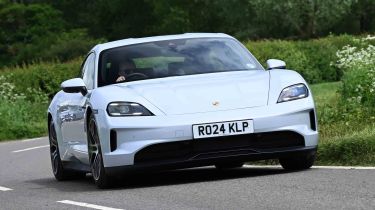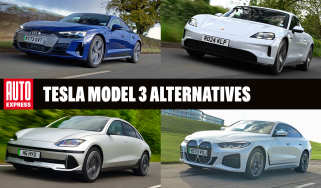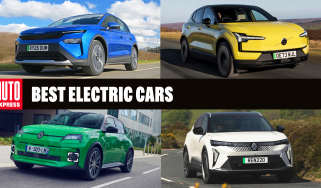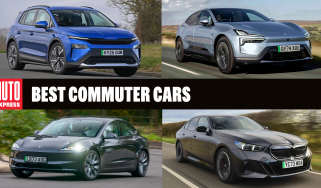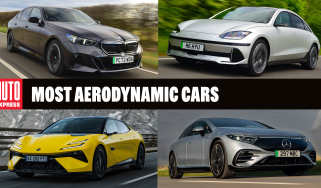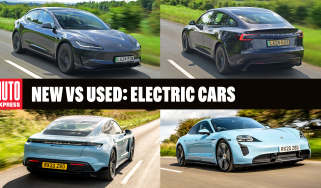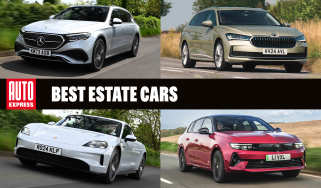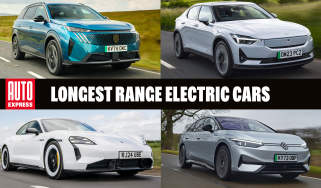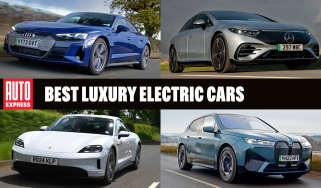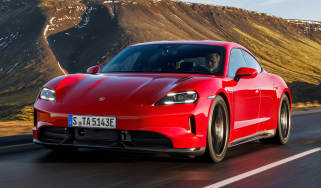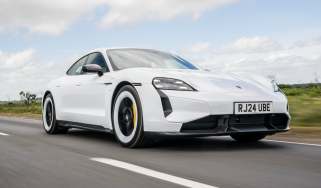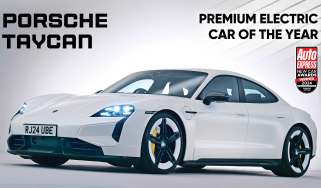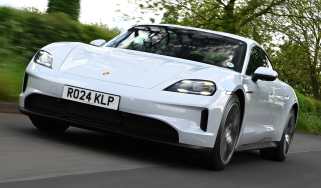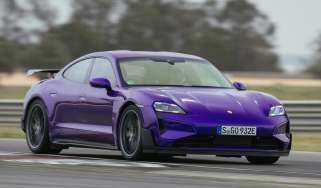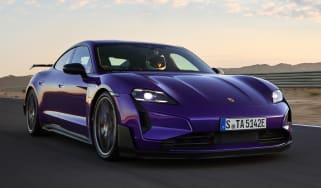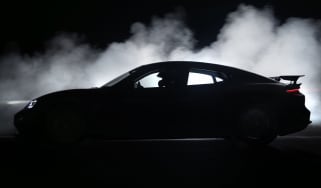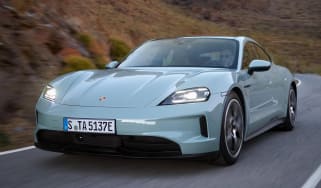Porsche Taycan review
More talented than ever, the Porsche Taycan is a sublime all-electric GT, blending impressive handling, practical range, and an engaging drive
Our opinion on the Porsche Taycan
You can't help but be impressed by the Porsche Taycan – and it remains one of our favourite electric cars. You'll need a supercar budget to afford one, but we think its combination of dynamic handling, breathtaking performance and superb long-distance comfort means it’s an obvious choice if you're after a reassuringly capable, premium all-electric saloon.
In 2024, Porsche introduced a facelifted model; increasing the Taycan's skillset even further with more range, better efficiency and faster acceleration. There’s no weak link in the model line-up either, and while the GTS and Turbo-badged variants may attract a lot of attention, the entry-level Taycan is as fast, efficient and comfortable as you could ever want.
| Key specs | |
| Fuel type | Electric |
| Body style | Four-door saloon |
| Powertrain | 105kWh (97kWh useable) battery, 1x e-motor, rear-wheel drive 105kWh (97kWh useable) battery, 1x e-motor, rear-wheel drive, 2x e-motor, four-wheel drive |
| Safety | 5-star Euro NCAP (2019) |
| Warranty | 3yrs/unlimited miles |
About the Porsche Taycan
Launched in 2019, the Porsche Taycan showed the world that an EV could deliver true sports car thrills. But more than that, it blended its dynamic ability with surprising comfort, a practical range, and rapid charging – making it a superb, if slightly pricey, all-electric option.
In addition to the four-door saloon (which is what we’ll cover primarily in this review), there’s also a five-door hatchback (or estate, depending on how you look at it) called the Porsche Taycan Sport Turismo, and a high-riding Porsche Taycan Cross Turismo variant as well. The saloon has the biggest range including 4S, GTS, Turbo, Turbo S and Turbo GT versions, plus a Turbo GT with Weissach package – a set-up that brings aerodynamic enhancements and weight reduction to further enhance its already blistering performance.
For 2025, Porsche has discontinued the entry 89kWh battery, leaving the larger 105kWh pack as standard across all cars. A key benefit of this move is that the Taycan gains a boost in overall range, to a maximum of 422 miles (WLTP).
With the Tesla Model S no longer available new in the UK, other rivals include the closely related Audi e-tron GT, along with the talented BMW i4 M50 and i7 M70, while some customers may look towards the luxurious, but less good to drive, Mercedes EQS. The i4 M50, at around £70,000, represents a relative bargain in this company, with the other German-made contenders all soaring past the £100k mark. Choose a high-specification version of the e-tron GT or the i7, perhaps with a few options, and you won't see any change from £160-170k.
You’ll pay around £88,000 for an entry-level Taycan; a car we maintain is so good that there's simply no need to choose a more expensive model. If you want more, the Taycan 4S costs from about £96,000, and the GTS a further £22,000 on top of that. The flagship Turbo GT rounds off the Taycan price list at almost £190,000 – with or without the Weissach Package.
If you go for the base car, you now get a range of up to 422 miles and a 0-62mph time of 4.8 seconds, which is more than fast enough for us. As you go up, the performance figures become a little ridiculous, topping out at 0-62mph in 2.2 seconds for the flagship Turbo GT Weissach Pack model.
Performance & driving experience
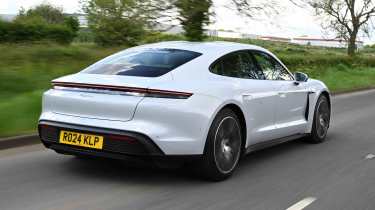
| Pros | Cons |
|
|
The Porsche Taycan has been built from the ground up to be a high-performance electric car. This means it’s brilliant to drive, which is all the more remarkable when you consider that this is a four-door coupe weighing over two tonnes.
You sit low in the Taycan, which gives the impression that you’re at the wheel of a Porsche 911, and it feels incredibly agile thanks to its low centre of gravity. The optional £1,600 rear-wheel steering certainly helps, as do the precise and well-weighted controls.
You can go even further on 4S models by adding something called Active Ride Control – a feature that works to improve comfort in corners and on bumpy roads while also being able to control body movements when accelerating, braking, or turning. It’s a nearly £6,500 option on 4S models and above, or you can get it on Turbo models for almost £7,000 as part of the Dynamic Package.
That’s a rather expensive option that you can live without, because aside from some slight jiggle over broken surfaces at speed, the standard-fit air suspension does a brilliant job of dealing with large bumps in a way you wouldn’t expect a low-slung four-door sports car to be able to manage. Above all else, the Taycan is so communicative that you never feel anything less than ‘at one’ with it.
Performance, 0-60mph acceleration and top speed
The base Porsche Taycan goes from 0-62mph in 4.8s using Launch Control and up to a top speed of 143mph. Upgrade to the 4S model and the benchmark time drops to 3.7 seconds, with a top speed of 155mph. The GTS knocks four tenths of a second from the 4S's time, while the Taycan Turbo hits 62mph from rest in 2.7 seconds and will hit a top speed of 162mph.
Splashing the extra cash for the Turbo S helps to cut the sprint time to 2.4 seconds, then the Turbo GT is on 2.3 seconds, with the Weissach Pack-equipped variant a tenth faster – with a 190mph maximum.
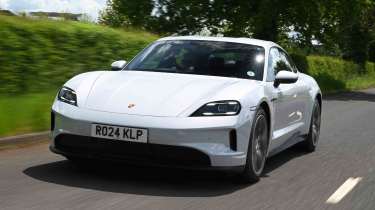
Town driving, visibility and parking
Considering the Taycan is capable of such ferocious performance, it's remarkably easy to pilot around town; with smooth acceleration and steering inputs you'll find it as simple and effortless to get from A to B as any 'normal' saloon.
All-round visibility is pretty good, despite the low-slung driving position, and parking manoeuvres are made easier by the standard reversing camera and front and rear ParkAssist technology. Drivers who spend most of their time in town may be put off by the Taycan's overall width – at 2.14 metres across it's no city car and it does take a little getting used to, particularly on congested urban streets.
B-road driving and handling
The Taycan is superb at piloting through twistier B-roads. It’s rapid, and handles brilliantly despite its two-tonne-plus weight, while the standard-fit air suspension just gives it even more dynamic polish. It's genuinely enjoyable to drive and encourages you to push on with confidence. Being picky, we found the brake pedal a little light in feel, with other testers remarking on how the regen system engaged a little too sharply at times - but we're talking in fractions here rather than any major irks.
Motorway driving and long-distance comfort
During our own test the Taycan was a tremendous long-distance cruiser; a car you felt you might easily skip off to France in and take a lazy road trip down to the Med. Comfortable, quiet and with plenty of power to tap into, the Taycan's GT ability is its real strength, while improvements to its efficiency and charging power mean you'll struggle to find any meaningful fault. Porsche has even added Adaptive Cruise Control and Lane Change Assist as standard to help smooth the journey along.
Expert view, on driving experience
“While some EVs are plain difficult to get in and drive, the Taycan is simple and intuitive to operate, with all the controls exactly where you need them." – Paul Adam, Executive editor, who tested an entry 429bhp Taycan model.
Range, charging and running costs
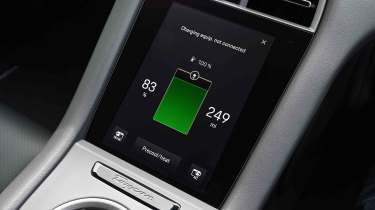
| Pros | Cons |
|
|
With the bigger 105kWh battery pack now standard across the range, the entry model can now - according to Porsche - manage up to 422 miles on a single charge. The Turbo-badged cars give up a little range in favour of extra power and true hypercar pace, with the top-of-the-range Turbo GT claimed to provide an average of 336 to 347 miles before needing to recharge.
Of course, what you achieve in the real world will depend on factors such as the weather, the accessories used within the car, and how hard you drive. We achieved a very impressive 4.0 miles-per-kilowatt-hour efficiency on a dry 20-degree day doing predominantly motorway miles.
Maximum charging speed is now 320kW, which means you could take a battery from 10 to 80 per cent in around 15 minutes at a suitable charging point, although topping up at a more common 150kW public charger requires a 33-minute pit stop.
Owners can take advantage of the Porsche Charging Service; a network that allows Porsche EV owners to charge their vehicles at a variety of public and private charging stations – with a single, centralised billing system. It offers access to over 800,000 charging points across Europe, and new Porsche EV owners can receive free access to the Porsche Charging Service Plus for up to three years.
| Model | Battery size | Range | Insurance group |
| Taycan 105kWh RWD | 105kWh | 422 miles | 48 |
| Taycan GTS 105kWh | 105kWh | 394 miles | 50 |
| Taycan Turbo GT 105kWh | 105kWh | 347 miles | 50 |
Insurance groups
There's no avoiding the reality of insuring a Porsche Taycan – it's going to be expensive, with the entry car in group 48 and all other models in group 50. In comparison, the Audi E-tron GT RS is also in group 50, along with the Lotus Emeya, while the BMW i4 M50 is in group 44.
Tax
From April 2025, EV owners will now pay a special first year tax rate of just £10, although from year two onwards this moves to an annual fee of £195. And, if you're electric car costs more than £40,000, then you'll have to pay the expensive vehicle supplement – a further £425 – between years two and six of ownership.
Depreciation
The high purchase cost of the Taycan and EV market uncertainty has resulted in some unusually low residual values for Porsche owners. After a typical three-year/36,000-mile ownership period, the Taycan is predicted to only hold onto around 36 to 38 per cent of its original value, with the 4S model faring slightly better at 42 per cent. Rivals such as the Lotus Emeya and Audi RS e-tron GT perform similarly, although the BMW i4 M50 and i7 M70 models are slightly stronger bets, retaining around 46-47 per cent over the same period.
Interior, design and technology
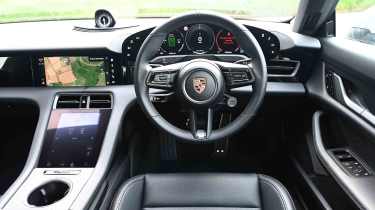
| Pros | Cons |
|
|
The Porsche Taycan is squat and wide, with the lowest centre of gravity of any of the brand’s current line-up. This is needed to counter the effects of the heavy battery pack it must carry around.
An update in 2024 changed the look very slightly, but it remains unmistakably a Porsche. The front is dominated by a pair of four-point LED headlights, with an optional matrix beam available. In profile, the Taycan looks more like a sports car than a four-door coupe, with a set of flush, automatically extending door handles to add to the theatre.
The rear design features a light strip made of glass, with the Porsche logo running along the middle. Above it is the three-stage rear spoiler system, while the absence of exhaust pipes gives the back a clean and uncluttered look.
Even the entry-level Taycan comes with a long list of standard equipment, including adaptive air suspension, LED headlights, part-leather seats, electric adjustment for the front seats, sat-nav and 19-inch alloy wheels.
The Taycan Turbo adds the likes of 20-inch alloy wheels, sports seats and Matrix LED headlights, while the Turbo S gets 21-inch alloy wheels, larger brakes and greater adjustment for the front seats. There’s also a long list of options to choose from.
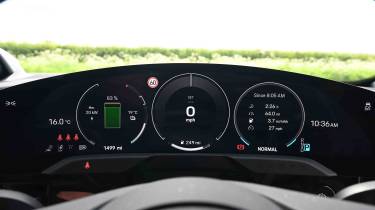
Interior and dashboard design
Inside, the seat position is derived from the Porsche 911, creating the best driving position you’ll find in the electric car segment. It’s a tech-heavy and minimalist approach, dominated by up to three digital screens and a centre console with touch control. There were some small tweaks as part of the 2024 facelift, but nothing major.
The only physical buttons are on the steering wheel and doors, creating a look that’s both modern and futuristic. Not everyone will appreciate the lack of buttons, but the interior looks stylish and upmarket.
Materials and build quality
With so many functions controlled vis the touchscreen, the Taycan's interior can feel almost spartan at first glance. But, take a moment to absorb the quality of the leather and softer materials in use, along with the excellent way in which everything is screwed together, and the Taycan is a very pleasant place in which to spend time.
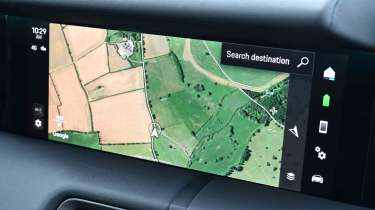
Infotainment, sat-nav and stereo
The Taycan has a dual-touchscreen layout: a 10.9-inch central touchscreen display as standard, along with a 16.8-inch curved display in front of the driver. The top display handles the standard infotainment, and the fast loading times and clear graphics mean that it does a great job. The one issue is with its position, which is recessed quite deep into the dash, so you might have to lean forward to adjust some functions.
This is mitigated slightly by the lower touchscreen, which includes shortcuts for the navigation, audio, telephone and system settings along its upper edge. The climate controls and heated seat functions are also operated using the screen, and because they are its primary function, they’re quite easy to access, if still not as easy to use on the move as a regular switch. It feels under-used, too; the portrait display is quite large, but there’s a lot of blank space. Wireless Apple CarPlay is a useful feature, and Porsche has added Android Auto tech.
Expert view, on design
“The modern and minimalist interior may not be to everyone's taste, but the Taycan's build quality is unquestionably superb." – Paul Adam, Executive editor, who tested an entry 429bhp Taycan model.
Boot space & practicality
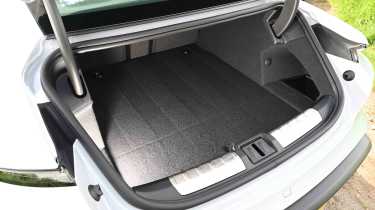
| Pros | Cons |
|
|
The Porsche Taycan is a triumph of good design, but there’s a touch of smoke and mirrors about the way it looks. While the similarly sized Porsche Panamera can look a tad cumbersome from some angles, the Taycan looks low and lithe, with styling that’s closer in spirit to the 911 than a four-door coupe.
The Taycan can seat four adults in comfort, with the driver and front passenger enjoying the best experience. That said, it’s a big car, which is something you’ll need to remember when parking and passing through narrow-width restrictions.
If you're after increased practicality, Porsche has introduced the higher-riding Cross Turismo body style, which offers improved interior and luggage space. A Sport Turismo model is also available and sits between the standard car and the Cross Turismo in the range. The sports seats are comfortable with good support and plenty of adjustments.
Dimensions and size
The Porsche Taycan is 4,963mm long and 2,144 wide, including the door mirrors. This means it’s wider but slightly shorter than the Porsche Panamera. It’s actually longer and wider than the Porsche Cayenne SUV, which gives you some idea of the size of the Taycan. Amazingly, it’s only 1,380mm high, which accentuates its broader look.
| Dimensions | |
| Length | 4,963mm |
| Width | 2,144mm (inc mirrors) |
| Height | 1,379mm |
| Number of seats | 4 seats (5th seat is an option) |
| Boot space | Front: 407 litres, rear: 81 litres |
Driving position, seats & space in the front
The front has plenty of headroom and shoulder room, and thanks to the electric seat adjustment, the driver will have no trouble finding the perfect driving position. The sports seats are comfortable and offer good support; perfect for longer journeys or more spirited driving.
Seats & space in the back
The Taycan can seat four adults, but it’s quite tricky to get into the back. Once there, headroom is restricted by the sloping roofline, while tall adults might find there’s not enough room for their feet below the front seats. The middle seat of cars with the 4+1 option is suitable only for small children and occasional use.
With this in mind, it’s probably worth sticking with the four-seat configuration, which swaps the middle seat for an armrest. There are also two ISOFIX mounting points in the back, along with an optional front passenger seat airbag with a deactivation function.
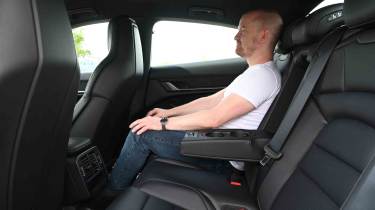
Boot space
The Porsche Taycan benefits from having an 81-litre luggage compartment in the front, while the main boot at the back is 407 litres. The saloon body style is a little restrictive when loading taller items, although that issue can be solved by opting for the more practical Taycan Sport Turismo or Taycan Cross Turismo, both of which have hatchback-style openings.
A large backpack or a soft bag can fit in the front boot, but the main boot isn’t as capacious as what you’ll find in some family hatchbacks. At least the Taycan boasts a pair of individually folding rear backrests, if you’re prepared to ditch your back-seat passengers in favour of more luggage space.
Expert view, on practicality
“The Taycan is perfectly able to serve as a good family car. Luggage capacity might be on the tight side if you're planning a roadtrip, but an approved Porsche roof box accessory solves the problem." – Paul Adam, Executive editor, who tested an entry 429bhp Taycan model.
Reliability and safety
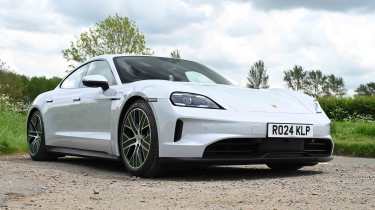
| Pros | Cons |
|
|
We don’t have enough data to include the Porsche Taycan in our current 2024 Driver Power customer satisfaction survey, but the Porsche brand managed to top the best manufacturers poll, with top marks in the ride and handling category as well as for its cars build quality and practicality.
Safety experts at Euro NCAP awarded the Taycan a maximum five-star rating when it was tested in 2019. The car scored particularly well for adult and child occupant protection. There are eight airbags, while pedestrians are protected by an active pop-up bonnet. Depending on the number of seats, four or five three-point belts with force limiters are fitted as standard.
As standard, you get an autonomous emergency braking system (AEB), a lane departure warning system, and a driver attention monitor, plus the previously optional adaptive cruise control and lane change assist are now also included without any additional charge. A head-up display is around £1,200, while a surround-view camera system with active parking technology is £1,100.
The £950 Innodrive option is a particularly clever system, using navigation data, radar, and video sensors to adjust the driving speed according to speed limits, topology, roundabouts, bends and traffic. It also features active lane-keeping assist, swerve assist and junction assist, which warns the driver if they have overlooked oncoming road users. A RECAS (Rear End Collision Alert System) actively warns the traffic behind of a potential rear-end collision.
| Key standard safety features | Euro NCAP safety ratings |
|
|
Buying and owning
- Best buy: Porsche Taycan 105kWh RWD
Money no object? If so, then opting for one of the ludicrous Turbo-badged Taycan models would probably be too hard to resist. But, for real-world driving, the entry model is more than up to the job, bringing a gorgeous combination of performance, range and lots of standard kit - a package that costs around £50,000 less than a Turbo car, and a mind-boggling £100k compared with the Turbo GT.
Every Porsche comes with a three-year/unlimited mileage warranty as standard, while a separate eight-year/100,000-mile warranty covers the Taycan’s battery.
The Porsche Taycan needs to be serviced every two years or 20,000 miles, which is a more generous interval than you get when buying a Porsche Panamera. The cost of maintenance is lower compared to the Taycan’s petrol and diesel counterparts. The interior cabin filter is the only filter that requires changing, while the brake fluid is the only fluid that requires maintenance at the two-year mark.
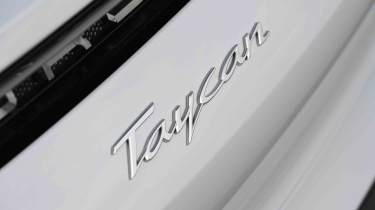
Alternatives
At this end of the market there's a host of dynamic brands competing for buyer's attention. The closely-related Audi e-tron GT is an extremely capable premium electric saloon and similarly priced, but we'd just give the edge to the Porsche on the fun factor.
The BMW i4 and i7 are credible rivals too, with the former in particular delivering an enticing package: all-wheel drive, 536bhp and 0-62mph in 3.9 seconds – although its 318-mile range is well down on the Taycan. Other options include the luxurious Mercedes EQS, but it doesn't quite measure up if you're looking to combine a premium feel with good driving dynamics, while there's also the more leftfield Lotus Emeya.
Porsche Taycan pictures
Frequently Asked Questions
It’s one of the best electric cars ever made and it has all the characteristics we expect of a Porsche. We think it’s a fantastic buy, as long as you can afford one.
